
  |
My Laudry TipsFor the respect of those many hours, for those exhausted eyes and overflowing imagination that these women had in the Past, it will remind me, that we need to transmit to our becoming generation this entire heirloom. Transmit also the love of old linen will be in some way, my vocation and yours too now. We have to convince ourselves that these pieces are now and then antiques, that they have a story, a soul. And thanks to you, will revive, brought back to their place with caring and loving. Vintage textiles are usually very sturdy. They were intended to last an entire lifetime, and often were passed down for another generation to use or because of lake of time, mothers used to give their ‘trousseau’ to be finished by their own daughters. In comparison of a cathedral construction and its many decades to rise up from the ground, the dexterity, patience and skilfulness were transmitted to the new workers. In this advice column, my purpose is to convey you in my own words what sorts of feeling you will get when you will succeed in cleaning a cloth and restore it to its immaculate white and raised embroidery. Especially when you know that this cloth has not been cleaned for almost 50 years! Then, take a comfortable seat, a cup of coffee in one hand, and please enjoy it... Your success will be mine! Now it is time to work… I wash all my old linen by hand; I do not rely on the washing machine (even new generation). Direct cause; the ironing is more painful as it sets wrinkles in the material and the spinning is too violent. Therefore, I always use my good old plastic bathe (never in aluminium or other metals to avoid chemical reaction). Never twist the linen; it will be the same result of spinning machine. I have tried almost anything that anyone has ever suggested. I've used (with varying results) automatic dishwasher detergent, white toothpaste, lemon juice and sunshine on very bad stains on whites, milk on stain and sunshine, many commercial whitener products, a mixture of sea salt with laundry powder with a little water put on stain then laid on the grass (with a water container underneath) and let the sunshine works, etc... Grimy, stored-stained, mouldy, linen sheet before washing: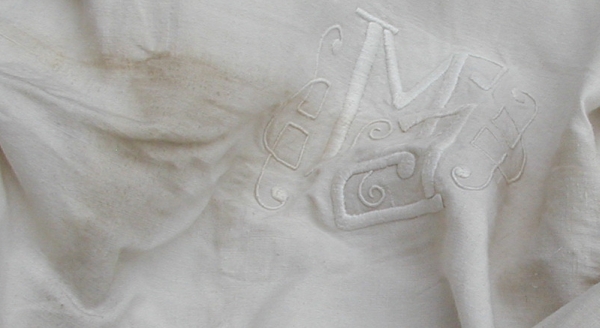 After 24 hours soaking, 24 hours sunshine method: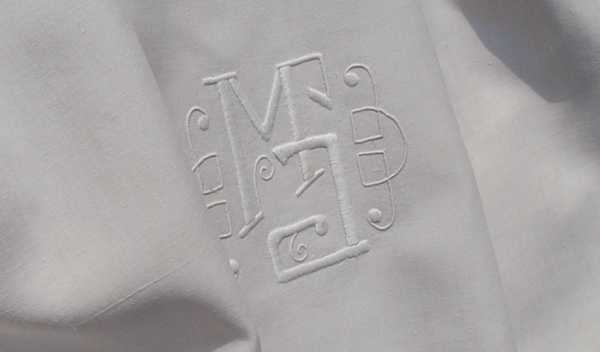 Grimy, mouldy, never washed 1890 night case with chemical lace: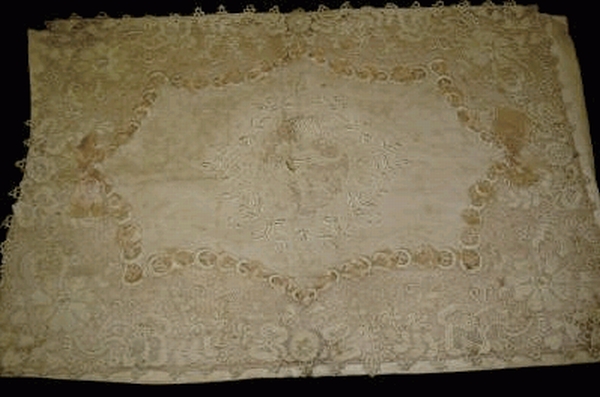 Repeated small soakings and at last milk treatment with sunshine method: PLEASE NOTE THAT I DO NOT GUARANTEE ANY METHOD THAT YOU CHOOSE TO TRY— THE FOLLOWING TIPS ARE IN NO WAY AN IMPLIED GUARANTEE. WHITES (linen, cotton, hemp)I fill my bathe with very hot water and allow items to soak for at least six hours with laundry detergent and a whitener called ‘Blanco’ like Oxiclean or ‘restoration’. I use a wooden stirrer to poke them and swish them. Small or delicate items are washed separately. I wash exceptionally fragile items inside pouches or pillowcases. I always do one white vinegar rinse which pulls any remaining soap or chemical residues from the fibres. Then, a clear rinse or two. Then, I drape them against the tub walls to drip. They get piled on top of one another and may drip there for a day, or even two days until I find time to press them. Blanco or if you prefer, Oxyclean who is more widely available + some white vinegar. You may also want to keep on hand a bottle of "Rust Remover" for more difficult rust stains. As with all products, I use much less than the manufacturer recommends and I repeat the treatment on very stubborn stains or rust. WASHING COLORS (linen, cotton, hemp)Always test colours to see if the colour runs! Never wash multiple items together unless you know for sure the coloured items (even coloured thread) will not run and ruin the other items. Been there, done that. Take my word for it, better to be cautious. I completely dissolve a generous amount of salt in cold water, and then gradually I'll add detergent, then the coloured items. This is supposed to prevent bleeding. Nothing is foolproof. Since some cleaning products work better in warmer (or HOT) water, I may add some. (Alternatively, soak an item for 5 minutes in cold water into which white vinegar has been added.). If an item is filthy, smelly and can't be used or displayed the way it is, I just take the risk. NoteDo not mix chemical treatments. Pre rinse items that may have bleach or detergent residue with vinegar to neutralize the bleach and then rinse twice in clear water before trying another treatment. Do not bleach anything after using Oxyclean or peroxide or any other chemical treatment. Your items may turn permanently blue. Rinse really, really well before trying any other product. SILK, LACE AND OTHER FRAGILE TEXTILESI do not recommend soaking this type of textiles, but advise few small washing. Do not scrub a stain with a brush or insist on it. To drip it, use a bath towel that you will lay down and put the item on it and then wrap and roll it. Then let it dry flat. You iron it damp with no steam. RINSEI always use white vinegar in one rinse which pulls any remaining soap or chemical residues from the fibres. Then, proceed to a clear rinse. IRONINGFirst of all, I recommend you to place thick cotton flannelette on your ironing board …the thicker you get, the better raised embroidery you will have. The cotton flannelette will absorb the embroidery and cocoon it while you iron on the other side. Always Iron items with the wrong side facing the iron. It is the best way to raise the embroidery and will give a wonderful effect to the fibres. First MethodTurn off the steam in your iron and let it dry out completely. I always iron with a dry iron at the medium (between cotton and linen) temperature I can get and never use steam. Try to time it so that things are slightly damp from washing or dampen with a spray bottle. Freezing them is supposed to make ironing easier. Wrap them in plastic and leave them in the freezer overnight or put them outside during the winter. Cover them with dry cleaner's plastic in your basket as you are ironing to keep them evenly dampened. I get better results without steam and I never get those streaky stains that happen when the steam dribbles out in dirty droplets. Iron items when you are ready to use them and do not iron them if you plan to store them for a long time (see storage below). Second MethodYou can use the steam but make sure you that you have a clean steam machine. Often, you will need to decaled it. Anyway, you will need to iron without steam for the final touch otherwise it will crease quickly. Iron pieces until they are very dry; if they are left ever-so-slightly damp, they happily wrinkle themselves as they dry. After ironing, hang them on drying racks for a few hours so that any residual dampness has a chance to completely evaporate while they are still in "formation." If you are going to use an item or display it, you can starch it while ironing. Starch is a personal preference and it does add a measure of protection against stains. If I use starch, I use a spray liquid starch called ‘robin ‘or you can mix with water and starch powder in a spray bottle. Please forget the ‘Grand-ma’ recipe with potatoes handmade starch; your item will be the pantry of all kind of insects. Dry, cleaned linen tray cloth with coloured-full embroidery: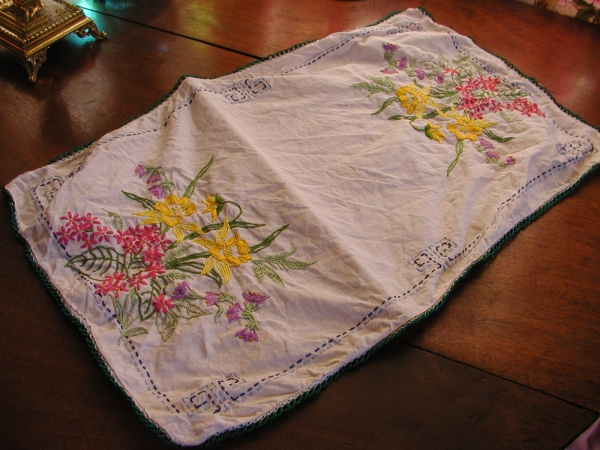 Ironed on back side with a light starching: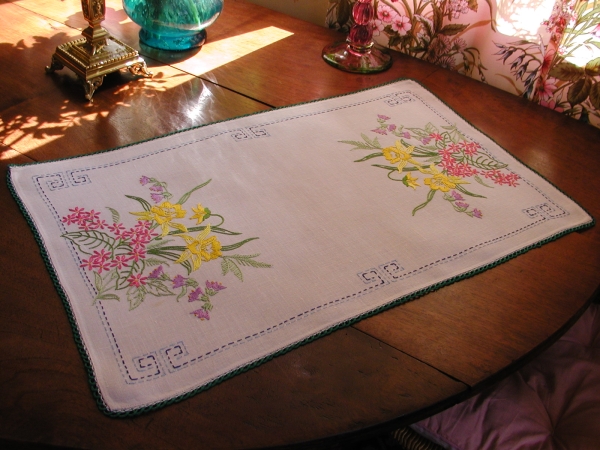 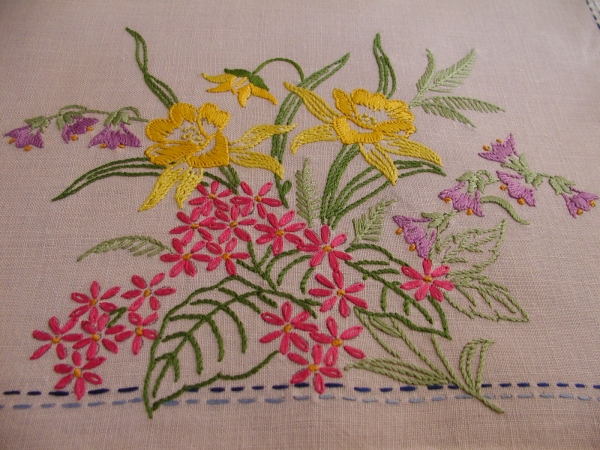 FRAGRANCESI was disappointed to find that the fragrance of the expensive French lavender-scented water dissipates once the pieces are dry, but I sometimes use it anyway because it makes the ironing experience so nice. One bottle has lasted almost two years so far. Other than that, I do not like scents in my laundry. Put some lavender sachet in your ‘armoire’, the result is much better and keep the insects away. STORAGEIf you plan to store things for any length of time, store them clean and loosely rolled, but not ironed, which can cause the creases to crack. Do not store them starched, which can attract moths that eat the starch along with any fibres that get in their way... which is most of them. Do not store them in wooden drawers, chests, trunks, suitcases or closets where the fabric can touch the wood. Line the drawers with acid-free tissue first or the acids in the wood fibres (even very old wood fibres) will leach out and stain your linens. You will be surprised how quickly they can turn yellow or brown when stored in things and dismayed by the fact that they need to be re-laundered. Roll or wrap your "long-term storage" and valuable linens in acid-free tissue paper. I hang ironed pieces because they take up less space and they don't wrinkle but rolling them is considered to be less stressful to the fibres. Store them dry, out of the light, but never in a damp place. Make sure they are thoroughly dry before you put them away. Have I said "dry" enough times? Go through your linens once a year or so to take stock, check them and enjoy them. If you store things folded and stacked, re-fold them with different creases. Stack heavier items on the bottom with the delicate ones on top. ONGOING MAINTENANCEIt really doesn't matter which detergent you use. Use what you have on hand but use a vinegar rinse to remove residue and rinse well after that. Soak your linens for a long time when they are really soiled. Pre treat stains with a stain remover; I use Ariel. If you can, leave them to soak overnight, or longer. If you feel comfortable with your washer on a gentle cycle, you can use it. But be aware that fragile embroidery, hemstitching or drawn work can tear under the strain of spinning. TO DRYEither hang things to dry over a tub or shower, lay them on the grass or fold them against the bathtub to drip inside the tub. (I layer a few dozen wet napkins and wait for them to slowly dry over the course of a day or two in preparation for ironing.) I may put items in the dryer for a few minutes when I desperately need to iron them, but I will always pull them out while they are fairly damp. (I do not do this often.) The dryer "sets" wrinkles and it becomes more work to iron them out. I find that sheets that have dried on the grass look good enough to be put on beds without being ironed. If something is fragile, soak and rinse it with a sheet beneath it; when you are ready to lift it from the water, lift the sheet which will support the item. MORE METHODSThe sunshine methodThis is the least invasive method; it is effective and it's free. It also sanitizes. The dry methodThis is for exceptionally fragile or delicate items which can not be immersed in water. Lay item on the grass in the sun and leave it for a few hours. Stains will lighten and will sometimes completely disappear. Turn over and leave for a few hours. Repeat if necessary. (I know that sunlight is destructive; I am not suggesting that you constantly subject your fragile items to sunlight. This method, used once or twice on a piece that would otherwise need to be thrown away, can be helpful.) The damp methodPre treat any stains with a paste obtained with a mixture of grey salt + your laundry powder and some water and lay your item outside on the grass in the early morning or the night before. Leave it in the sun for a day or two. Visit it each morning to check it, turn it and dampen it with a spray bottle of water. The sun does the work, interacting with the water and the chlorophyll in the grass. This also deodorizes and sanitizes! Bird or insect droppings are a downside to this method and I have had an occasional cat sitting or walking on them, too, but 95% of the time I bring my sheets inside and pop them directly on the beds without a problem. And the fresh air smell is wonderful. The smell even lasts through ironing! OTHER STAIN TREATMENTSBoiling used to be quite common, but when I think about it, I have no boiler big enough to hold a large and heavy linen sheet or a large tablecloth. I can't quite imagine doing it on the cook top in a pasta pot! Dishwasher detergent mixed in a paste with plain borax is one I haven't tried, but one of my sources swears by it. Someone else sprays peroxide on stains. As with everything, nothing is predictable or perfect. Bleach is the LAST RESORT. No matter how tempting, I try not to use it because it eats away the fibres of the fabric. I do, however, use it as a last resort on items that I would otherwise throw away. If you must use chlorine bleach, it is better to use less and soak longer. But if you do soak something overnight in bleach, rinse it well in a vinegar water rinse. This neutralizes the bleach and strips out the soap. Then rinse again. As many as you can.  This painting illustrates the long history of this kind of care! Of course, this is a spring and summer suggestion, you need the green grass with chlorophyll interacting with sunlight or moonlight and damp fabric. Patience is your best ally! However, you can place items on the snow in winter time. This works well, too. (The painting, "Flemish Market and Washhouse" was painted by Pieter Bruegel (c1520-1569) and it is in the Prado in Madrid.) This is what my lawn looks like for most of the summer. Enjoy your treasures! Stéphanie (chezfanny@triplezero.net). |
|
Au Fil Du Lin Et Coton - RCS Melun 482 671 278 - 2, Rue de Verdun - 77940 Thoury Ferrottes - France |